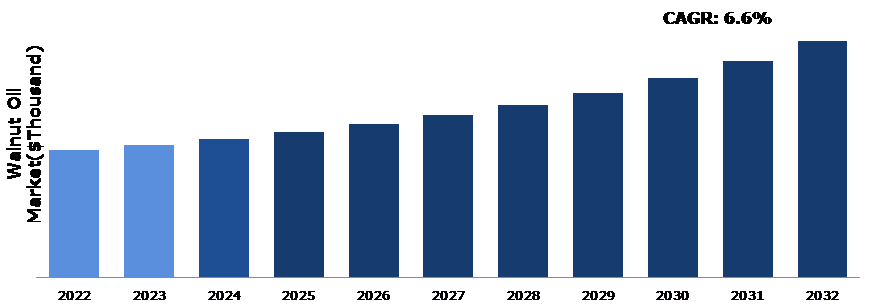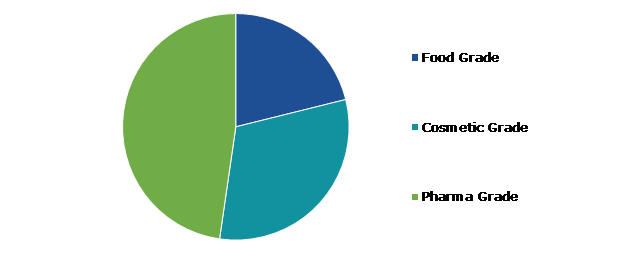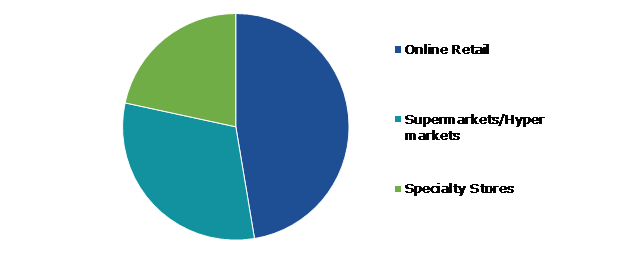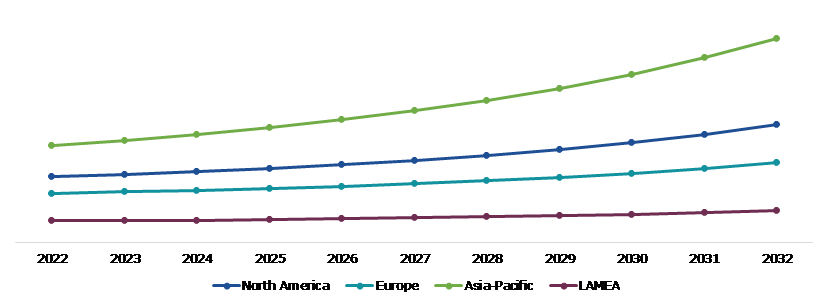Walnut Oil Market Report
RA09224
Walnut Oil Market by Grade (Food Grade, Cosmetic Grade, and Pharma Grade), Application (Food & Beverage, Cosmetics, Pharmaceuticals, Aromatherapy, and Others), Distribution Channel (Online Retail, Supermarkets/Hypermarkets, and Specialty Stores), and Region (North America, Europe, Asia-Pacific, and LAMEA): Global Opportunity Analysis and Industry Forecast, 2023-2032
Walnut Oil Overview
Walnut oil is a nutritious cooking oil derived from walnut tree nuts. It takes on a rich, nutty taste after being cold-pressed and preserves a wide range of vitamins, antioxidants, and omega-3 fatty acids. Because of its unique flavor, this versatile oil is extensively used in cooking, salad dressings, and as a finishing oil. Walnut oil is produced by pressing walnuts until all of the oils have been removed. It is a golden-brown oil with a sweet, nutty style that turns into barely astringent when heated to tons due to the fact walnut oil is an ingredient with a low smoke point.
Global Walnut Oil Market Analysis
The global walnut oil market size was $925,412.0 thousand in 2022 and is predicted to grow with a CAGR of 6.6%, by generating a revenue of $1,718,786.4 thousand by 2032.
Source: Research Dive Analysis
COVID-19 Impact on the Global Walnut Oil Market
The COVID-19 pandemic has affected almost every industry, and the long-term effects are projected to impact industry growth during the forecast period as well. Lockdowns, supply chain challenges, and decreased consumer spending impacted production and distribution. With increased health consciousness, there was a surge in demand for nutritious oils. The market adapted to changing consumer preferences by emphasizing product quality and health benefits. Despite initial setbacks, gradual recovery ensued as global conditions improved. The walnut oil market's resilience and adaptation strategies played a crucial role in navigating the challenges posed by the pandemic, fostering stability and growth.
The walnut oil industry has witnessed a resurgence as global economies recover. The demand for walnut oil is expected to increase owing to rising consumer awareness regarding the health benefits associated with walnut oil. The market is driven by a growing preference for natural, nutritious ingredients in cooking. In addition, the rising popularity of gourmet and healthy eating trends further boosts walnut oil consumption. As supply chains stabilize, manufacturers focus on sustainable sourcing, contributing to the market growth and emphasizing the product's appeal in the post-pandemic period.
Growing Health Awareness Regarding Consumption of Walnut Oil to Drive Market Growth
The walnut oil helps to reduce the risk of abnormal heartbeats or arrhythmias, mitigating the risk of abnormal heart rhythms and decreasing triglyceride levels. In the current health-conscious landscape, customers increasingly include preventive care as vital to a healthy lifestyle. Walnut oils achieve importance due to their rich dietary factors, prosperous in vitamins, proteins, and minerals. Beyond cardiovascular benefits, walnut oil is recognized for its viability in ailment management, playing a key role in addressing conditions such as cancer, asthma, and depression. As individuals prioritize holistic wellness, walnut oils emerge as not simply a culinary preference but a health-enhancing component, aligning with the broader shift toward proactive health measures.
Increase in Price of High-Quality Walnut Oils to Restrain the Market Growth
The market for walnut oils faces a challenge as prices continue to rise. The increasing cost of producing premium walnut oils puts a constraint on the market growth. Consumers seeking superior quality and health benefits may find these high prices a deterrent, impacting overall market expansion. As the demand for walnut oils clashes with cost pressures, suppliers and consumers need to navigate the delicate balance between quality and affordability. The industry needs to strategize and explore sustainable practices to maintain competitiveness and accessibility, ensuring that the benefits of high-quality walnut oils remain attainable for a broad consumer base despite the prevailing upward price trend. All these factors are anticipated to restrict the market growth during the forecast period.
Increase in Use of Walnut Oil in the Cosmetics Industry to Drive Excellent Opportunities
Walnut oil, derived from walnuts, has several cosmetic benefits. The walnut oil is known for its rich nutritional profile and advantageous properties for both hair and skin. Recognized as a superb nourishing agent, walnuts are substantially utilized in skincare, especially for treating issues like dark circles. The beauty industry has witnessed a notable increase in the incorporation of walnut oil, used in body massages and aromatherapy. Beyond its soothing qualities, walnut oil proves recommended in addressing fungal infections like ringworm and athlete's foot. Its omega-6 fatty acids also contribute to the stimulation of hair growth. Moreover, walnut oil performs a pivotal role in bettering skin texture, hydration, and elasticity, owing to its nourishing and moisturizing attributes. Its herbal ingredient align with the rising buyer requirement for herbal and natural elements in cosmetics. The trend towards natural and high-quality ingredients has significantly enhanced the incorporation of walnut oil in a range of skincare and haircare products. The cosmetics industry's increasing dependence on walnut oil is expected to be a key driver in the global walnut market growth during the forecast period. This surge is attributed to the rising consumer preference for natural elements, positioning walnut oil as an essential component in cosmetic formulations.
Global Walnut Oil Market Share, by Grade, 2022
Source: Research Dive Analysis
The pharma grade sub-segment accounted for the highest market share in 2022. The pharmaceutical-grade segment is a pivotal driving force in the walnut oil market, witnessing an increase in demand due to the oil's medicinal properties. Walnut oil's therapeutic benefits, such as helping in the therapy of several skin conditions and promoting hair health, contribute to its growing integration into pharmaceutical applications. The industry's focus on natural and organic elements increases walnut oil's enchantment in pharmaceutical formulations. As buyers prioritize holistic well-being, the pharmaceutical-grade segment is positioned for substantial growth. This surge is driven by the recognition of walnut oil as a valuable element in medicinal and therapeutic applications, aligning with the evolving preferences for wellness-centric pharmaceutical solutions. All these factors are projected to drive the segment growth during the forecast period.
Global Walnut Oil Market Share, by Application, 2022
Source: Research Dive Analysis
The pharmaceuticals sub-segment accounted for the highest market share in 2022. The pharmaceutical segment is a key driver in the walnut oil market, utilizing the oil's numerous therapeutic properties. Walnut oil, renowned for its nutritional richness, finds utility in skincare and haircare formulations. Its incidence in prescribed drugs is attributed to its efficacy in treating conditions like fungal infections and promoting skin and hair health. As consumers prioritize holistic well-being, the integration of walnut oil in pharmaceutical products is expected to remain a pivotal component driving market growth in this dynamic section.
Global Walnut Oil Market Share, by Distribution Channel, 2022
Source: Research Dive Analysis
The online retail sub-segment accounted for the highest market share in 2022. The walnut oil market is experiencing huge growth, with the online retail section rising as a pivotal force. The convenience and accessibility of online systems have extensively contributed to increasing the market reach, allowing buyers handy access to several varieties of walnut oil products. Online retail channels offer a convenient way for shoppers to explore, compare, and buy walnut oil from the comfort of their homes. This digital shift now not only caters to the evolving purchasing preferences of shoppers but also facilitates a worldwide market boom through the ability to surpass geographical constraints.
Global Walnut Oil Market Size & Forecast, by Region, 2022-2032 ($Thousand)
Source: Research Dive Analysis
The Asia-Pacific walnut oil market generated the highest revenue in 2022. The Asia-Pacific walnut oil market is witnessing strong growth, primarily driven by an increased awareness regarding health and well-being among consumers. The sought-after nutritional composition of walnut oil, combined with its recognized benefits for skin, hair, and overall well-being, is driving the increase in demand. The growing trend of incorporating natural ingredients in cosmetic and personal care products is also contributing to market expansion in the region. Consumers in Asia-Pacific are adopting walnut oil into their daily routines, considering it as a complete solution. Furthermore, the expanding food industry and culinary applications are propelling regional market growth, as chefs and home cooks appreciate its unique flavor and health attributes. All these factors projected to drive the Asia-Pacific walnut oil market
Competitive Scenario in the Global Walnut Oil Market
Investment and agreement are common strategies followed by major market players. One of the leading market players in the industry is Forbidden Foods. For instance, on June 28, 2021, Forbidden Foods, an ASX-listed company, launched several walnut/macadamia oil supplements containing algal omega-3 in China and Australia based on customer patterns identified on the major e-commerce site Alibaba Tmall. The oil can be blended with cereals, boiling grains, mashed vegetables, and salads.
Source: Research Dive Analysis
Some of the leading walnut oil market analysis players are KUNHUA BIOLOGICAL TECHNOLOGY CO., LTD, Ji'An ZhongXiang Natural Plants Co.,Ltd., AOS Products Pvt. Ltd., Chinaplantoil, VedaOils, Plenty Foods, AG Industries, SVA Organics, O&3 Limited, and Roland Foods, LLC.
| Aspect | Particulars |
| Historical Market Estimations | 2020-2022 |
| Base Year for Market Estimation | 2022 |
| Forecast Timeline for Market Projection | 2023-2032 |
| Geographical Scope | North America, Europe, Asia-Pacific, and LAMEA |
| Segmentation by Grade |
|
| Segmentation by Application |
|
|
Segmentation by Distribution Channel
|
|
| Key Companies Profiled |
|
Q1. What is the size of the global walnut oil market?
A. The size of the global walnut oil market size was over $925,412.0 thousand in 2022 and is projected to reach $1,718,786.4 thousand by 2032.
Q2. Which are the major companies in the walnut oil market?
A. KUNHUA BIOLOGICAL TECHNOLOGY CO., LTD, Ji'An ZhongXiang Natural Plants Co.,Ltd., AOS Products Pvt. Ltd., Chinaplantoil, and VedaOils are some of the key players in the global walnut oil market.
Q3. Which region, among others, possesses greater investment opportunities in the future?
A. Asia-Pacific possesses great investment opportunities for investors in the future.
Q4. What will be the growth rate of the Asia-Pacific walnut oil market?
A. The Asia-Pacific walnut oil market share is anticipated to grow at 8.0% CAGR during the forecast period.
Q5. What are the strategies opted by the leading players in this market?
A. Agreement and investment are the two key strategies opted by the operating companies in this market.
Q6. Which companies are investing more on R&D practices?
A. KUNHUA BIOLOGICAL TECHNOLOGY CO., LTD, Ji'An ZhongXiang Natural Plants Co.,Ltd., AOS Products Pvt. Ltd., Chinaplantoil, and VedaOils are the companies investing more on R&D activities for developing new products and technologies.
1. Research Methodology
1.1. Desk Research
1.2. Real time insights and validation
1.3. Forecast model
1.4. Assumptions and forecast parameters
1.5. Market size estimation
1.5.1. Top-down approach
1.5.2. Bottom-up approach
2. Report Scope
2.1. Market definition
2.2. Key objectives of the study
2.3. Report overview
2.4. Market segmentation
2.5. Overview of the impact of COVID-19 on global walnut oil market
3. Executive Summary
4. Market Overview
4.1. Introduction
4.2. Growth impact forces
4.2.1. Drivers
4.2.2. Restraints
4.2.3. Opportunities
4.3. Market value chain analysis
4.3.1. List of raw material suppliers
4.3.2. List of manufacturers
4.3.3. List of distributors
4.4. Innovation & sustainability matrices
4.4.1. Technology matrix
4.4.2. Regulatory matrix
4.5. Porter’s five forces analysis
4.5.1. Bargaining power of suppliers
4.5.2. Bargaining power of consumers
4.5.3. Threat of substitutes
4.5.4. Threat of new entrants
4.5.5. Competitive rivalry intensity
4.6. PESTLE analysis
4.6.1. Political
4.6.2. Economical
4.6.3. Social
4.6.4. Technological
4.6.5. Legal
4.6.6. Environmental
4.7. Impact of COVID-19 on walnut oil market
4.7.1. Pre-covid market scenario
4.7.2. Post-covid market scenario
5. Walnut Oil Market Analysis, by Grade
5.1. Overview
5.2. Food Grade
5.2.1. Definition, key trends, growth factors, and opportunities
5.2.2. Market size analysis, by region, 2022-2032
5.2.3. Market share analysis, by country, 2022-2032
5.3. Cosmetic Grade
5.3.1. Definition, key trends, growth factors, and opportunities
5.3.2. Market size analysis, by region, 2022-2032
5.3.3. Market share analysis, by country, 2022-2032
5.4. Pharma Grade
5.4.1. Definition, key trends, growth factors, and opportunities
5.4.2. Market size analysis, by region, 2022-2032
5.4.3. Market share analysis, by country, 2022-2032
5.5. Research Dive Exclusive Insights
5.5.1. Market attractiveness
5.5.2. Competition heatmap
6. Walnut Oil Market Analysis, by Application
6.1. Food & Beverage
6.1.1. Definition, key trends, growth factors, and opportunities
6.1.2. Market size analysis, by region, 2022-2032
6.1.3. Market share analysis, by country, 2022-2032
6.2. Cosmetics
6.2.1. Definition, key trends, growth factors, and opportunities
6.2.2. Market size analysis, by region, 2022-2032
6.2.3. Market share analysis, by country, 2022-2032
6.3. Pharmaceuticals
6.3.1. Definition, key trends, growth factors, and opportunities
6.3.2. Market size analysis, by region, 2022-2032
6.3.3. Market share analysis, by country, 2022-2032
6.4. Aromatherapy
6.4.1. Definition, key trends, growth factors, and opportunities
6.4.2. Market size analysis, by region, 2022-2032
6.4.3. Market share analysis, by country, 2022-2032
6.5. Others
6.5.1. Definition, key trends, growth factors, and opportunities
6.5.2. Market size analysis, by region, 2022-2032
6.5.3. Market share analysis, by country, 2022-2032
6.6. Research Dive Exclusive Insights
6.6.1. Market attractiveness
6.6.2. Competition heatmap
7. Walnut Oil Market Analysis, by Distribution Channel
7.1. Online Retail
7.1.1. Definition, key trends, growth factors, and opportunities
7.1.2. Market size analysis, by region, 2022-2032
7.1.3. Market share analysis, by country, 2022-2032
7.2. Supermarkets/Hypermarkets
7.2.1. Definition, key trends, growth factors, and opportunities
7.2.2. Market size analysis, by region, 2022-2032
7.2.3. Market share analysis, by country, 2022-2032
7.3. Specialty Stores
7.3.1. Definition, key trends, growth factors, and opportunities
7.3.2. Market size analysis, by region, 2022-2032
7.3.3. Market share analysis, by country, 2022-2032
7.4. Research Dive Exclusive Insights
7.4.1. Market attractiveness
7.4.2. Competition heatmap
8. Walnut oil Market, by Region
8.1. North America
8.1.1. U.S.
8.1.1.1. Market size analysis, by Grade, 2022-2032
8.1.1.2. Market size analysis, by Application, 2022-2032
8.1.1.3. Market size analysis, by Distribution Channel, 2022-2032
8.1.2. Canada
8.1.2.1. Market size analysis, by Grade, 2022-2032
8.1.2.2. Market size analysis, by Application, 2022-2032
8.1.2.3. Market size analysis, by Distribution Channel, 2022-2032
8.1.3. Mexico
8.1.3.1. Market size analysis, by Grade, 2022-2032
8.1.3.2. Market size analysis, by Application, 2022-2032
8.1.3.3. Market size analysis, by Distribution Channel, 2022-2032
8.1.4. Research Dive Exclusive Insights
8.1.4.1. Market attractiveness
8.1.4.2. Competition heatmap
8.2. Europe
8.2.1. Germany
8.2.1.1. Market size analysis, by Grade, 2022-2032
8.2.1.2. Market size analysis, by Application, 2022-2032
8.2.1.3. Market size analysis, by Distribution Channel, 2022-2032
8.2.2. UK
8.2.2.1. Market size analysis, by Grade, 2022-2032
8.2.2.2. Market size analysis, by Application, 2022-2032
8.2.2.3. Market size analysis, by Distribution Channel, 2022-2032
8.2.3. France
8.2.3.1. Market size analysis, by Grade, 2022-2032
8.2.3.2. Market size analysis, by Application, 2022-2032
8.2.3.3. Market size analysis, by Distribution Channel, 2022-2032
8.2.4. Spain
8.2.4.1. Market size analysis, by Grade, 2022-2032
8.2.4.2. Market size analysis, by Application, 2022-2032
8.2.4.3. Market size analysis, by Distribution Channel, 2022-2032
8.2.5. Italy
8.2.5.1. Market size analysis, by Grade, 2022-2032
8.2.5.2. Market size analysis, by Application, 2022-2032
8.2.5.3. Market size analysis, by Distribution Channel, 2022-2032
8.2.6. Rest of Europe
8.2.6.1. Market size analysis, by Grade, 2022-2032
8.2.6.2. Market size analysis, by Application, 2022-2032
8.2.6.3. Market size analysis, by Distribution Channel, 2022-2032
8.2.7. Research Dive Exclusive Insights
8.2.7.1. Market attractiveness
8.2.7.2. Competition heatmap
8.3. Asia-Pacific
8.3.1. China
8.3.1.1. Market size analysis, by Grade, 2022-2032
8.3.1.2. Market size analysis, by Application, 2022-2032
8.3.1.3. Market size analysis, by Distribution Channel, 2022-2032
8.3.2. Japan
8.3.2.1. Market size analysis, by Grade, 2022-2032
8.3.2.2. Market size analysis, by Application, 2022-2032
8.3.2.3. Market size analysis, by Distribution Channel, 2022-2032
8.3.3. India
8.3.3.1. Market size analysis, by Grade, 2022-2032
8.3.3.2. Market size analysis, by Application, 2022-2032
8.3.3.3. Market size analysis, by Distribution Channel, 2022-2032
8.3.4. Australia
8.3.4.1. Market size analysis, by Grade, 2022-2032
8.3.4.2. Market size analysis, by Application, 2022-2032
8.3.4.3. Market size analysis, by Distribution Channel, 2022-2032
8.3.5. South Korea
8.3.5.1. Market size analysis, by Grade, 2022-2032
8.3.5.2. Market size analysis, by Application, 2022-2032
8.3.5.3. Market size analysis, by Distribution Channel, 2022-2032
8.3.6. Rest of Asia-Pacific
8.3.6.1. Market size analysis, by Grade, 2022-2032
8.3.6.2. Market size analysis, by Application, 2022-2032
8.3.6.3. Market size analysis, by Distribution Channel, 2022-2032
8.3.7. Research Dive Exclusive Insights
8.3.7.1. Market attractiveness
8.3.7.2. Competition heatmap
8.4. LAMEA
8.4.1. Brazil
8.4.1.1. Market size analysis, by Grade, 2022-2032
8.4.1.2. Market size analysis, by Application, 2022-2032
8.4.1.3. Market size analysis, by Distribution Channel, 2022-2032
8.4.2. Saudi Arabia
8.4.2.1. Market size analysis, by Grade, 2022-2032
8.4.2.2. Market size analysis, by Application, 2022-2032
8.4.2.3. Market size analysis, by Distribution Channel, 2022-2032
8.4.3. UAE
8.4.3.1. Market size analysis, by Grade, 2022-2032
8.4.3.2. Market size analysis, by Application, 2022-2032
8.4.3.3. Market size analysis, by Distribution Channel, 2022-2032
8.4.4. South Africa
8.4.4.1. Market size analysis, by Grade, 2022-2032
8.4.4.2. Market size analysis, by Application, 2022-2032
8.4.4.3. Market size analysis, by Distribution Channel, 2022-2032
8.4.5. Rest of LAMEA
8.4.5.1. Market size analysis, by Grade, 2022-2032
8.4.5.2. Market size analysis, by Application, 2022-2032
8.4.5.3. Market size analysis, by Distribution Channel, 2022-2032
8.4.6. Research Dive Exclusive Insights
8.4.6.1. Market attractiveness
8.4.6.2. Competition heatmap
9. Competitive Landscape
9.1. Top winning strategies, 2022
9.1.1. By strategy
9.1.2. By year
9.2. Strategic overview
9.3. Market share analysis, 2022
10. Company Profiles
10.1. KUNHUA BIOLOGICAL TECHNOLOGY CO., LTD
10.1.1. Overview
10.1.2. Business segments
10.1.3. Product portfolio
10.1.4. Financial performance
10.1.5. Recent developments
10.1.6. SWOT analysis
10.2. Ji'An ZhongXiang Natural Plants Co.,Ltd.
10.2.1. Overview
10.2.2. Business segments
10.2.3. Product portfolio
10.2.4. Financial performance
10.2.5. Recent developments
10.2.6. SWOT analysis
10.3. AOS Products Pvt. Ltd.
10.3.1. Overview
10.3.2. Business segments
10.3.3. Product portfolio
10.3.4. Financial performance
10.3.5. Recent developments
10.3.6. SWOT analysis
10.4. Chinaplantoil
10.4.1. Overview
10.4.2. Business segments
10.4.3. Product portfolio
10.4.4. Financial performance
10.4.5. Recent developments
10.4.6. SWOT analysis
10.5. VedaOils
10.5.1. Overview
10.5.2. Business segments
10.5.3. Product portfolio
10.5.4. Financial performance
10.5.5. Recent developments
10.5.6. SWOT analysis
10.6. Plenty Foods
10.6.1. Overview
10.6.2. Business segments
10.6.3. Product portfolio
10.6.4. Financial performance
10.6.5. Recent developments
10.6.6. SWOT analysis
10.7. AG Industries
10.7.1. Overview
10.7.2. Business segments
10.7.3. Product portfolio
10.7.4. Financial performance
10.7.5. Recent developments
10.7.6. SWOT analysis
10.8. SVA Organics
10.8.1. Overview
10.8.2. Business segments
10.8.3. Product portfolio
10.8.4. Financial performance
10.8.5. Recent developments
10.8.6. SWOT analysis
10.9. O&3 Limited
10.9.1. Overview
10.9.2. Business segments
10.9.3. Product portfolio
10.9.4. Financial performance
10.9.5. Recent developments
10.9.6. SWOT analysis
10.10. Roland Foods, LLC
10.10.1. Overview
10.10.2. Business segments
10.10.3. Product portfolio
10.10.4. Financial performance
10.10.5. Recent developments
10.10.6. SWOT analysis
Personalize this research
- Triangulate with your own data
- Request your format and definition
- Get a deeper dive on a specific application, geography, customer or competitor
- + 1-888-961-4454 Toll - Free
- support@researchdive.com







